Psychophysical responses in patients receiving a mock laser within context of an acupuncture clinical trial: an interoceptive perspective
- PMID: 28673350
- PMCID: PMC5496139
- DOI: 10.1186/s12906-017-1859-0
Psychophysical responses in patients receiving a mock laser within context of an acupuncture clinical trial: an interoceptive perspective
Abstract
Background: The psychophysical responses induced by verum acupuncture are characterized by a constellation of unique subjective sensory responses commonly termed De Qi. Furthermore, a variety of sham interventions have been used as a control for acupuncture clinical trials. Indeed, one such control has been mock laser which has been used as control intervention in several acupuncture clinical controlled trials. The current study aim was to examine the De Qi sensory responses and its related characteristics elicited from acupuncture and compare them to those reported following sham laser in participants enrolled in a clinical trial.
Methods: The study was embedded in a multi-center, two-arm randomised clinical trial, which evaluated the effect of acupuncture on lateral elbow pain. De Qi was assessed using the Massachusetts General Hospital Acupuncture Sensation Scale (MASS). Ninety-six participants were randomly allocated to receive either acupuncture (n = 47) or mock laser (n = 49) at the acupoints LI 10 and LI 11.
Results: Participants in both intervention groups reported similar De Qi psychophysical characteristics; however, both intensity and frequency of the individually perceived De Qi characteristics were significantly higher in the acupuncture group. 'Soreness', 'deep pressure', and 'fullness-distension' in the acupuncture group and 'tingling', and 'sharp pain' in mock laser group, were identified as the leading characteristics. Similar level of MASS De Qi Index (MDI) scores were reported for 'Hong Kong-China' and 'Australia-Italy' with a significantly higher level of De Qi reported by 'Hong Kong-China'. Furthermore, two distinct De Qi categories were identified, namely De Qi (in line with classical sensory responses of Suan, Ma, Zhang, and Zhong) and pain.
Conclusions: Subjective 'somatic or interoceptive awareness' should be taken into account when De Qi psychophysical responses are examined. The study accentuates the necessity and the significance of further research into interoception phenomenon which may contribute to a better understanding of the placebo effect and De Qi psychophysical responses.
Trial registration: Australian and New Zealand Clinical Trial Registry reference: ACTRN12613001138774 on 11th of October 2013.
Keywords: Acupuncture; De Qi; Interoceptive; Mock laser; Psychophysical responses.
Conflict of interest statement
Ethics approval and consent to participate
Human ethics approval was sought and obtained at each site (University of Technology Sydney, Australia; Hong Kong Baptist University, Hong Kong; Changchun University of Traditional Chinese Medicine, China and Istituto Paracelso, Italy). This trial was registered with the Australian and New Zealand Clinical Trial Registry on the 11th of October 2013 (Identifier: ACTRN12613001138774).
Consent for publication
All authors consented to publication.
Competing interests
The authors declare that they have no competing interests.
Publisher’s Note
Springer Nature remains neutral with regard to jurisdictional claims in published maps and institutional affiliations.
Figures
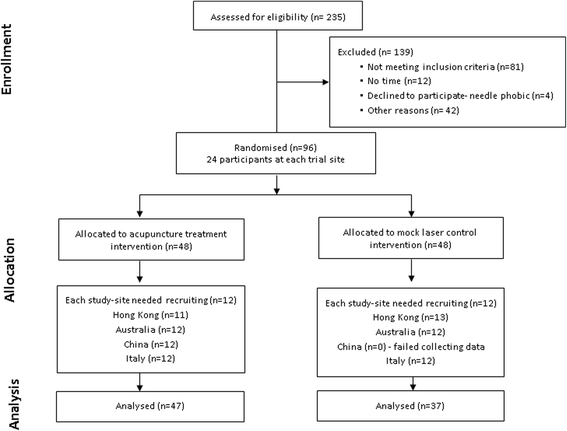
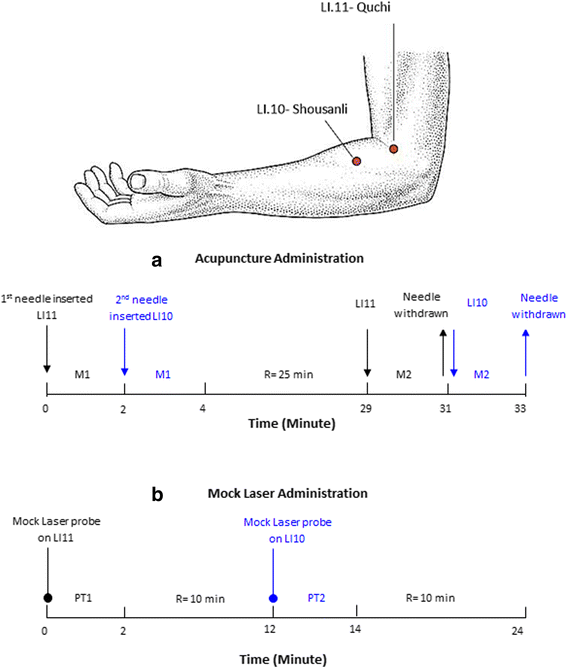
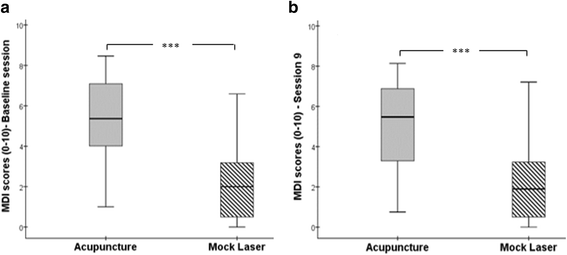
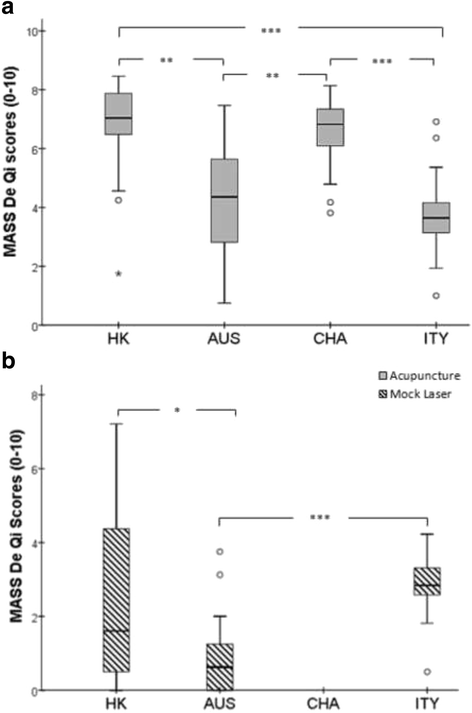

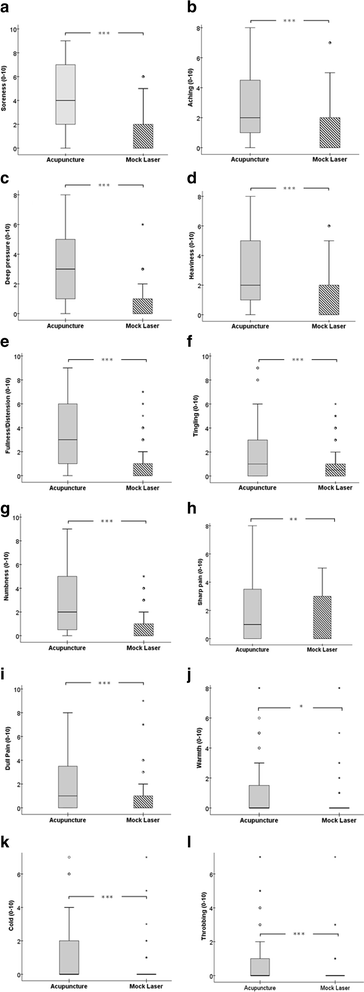
Similar articles
-
Anxiety related to De Qi psychophysical responses as measured by MASS: A sub-study embedded in a multisite randomised clinical trial.Complement Ther Med. 2018 Aug;39:24-35. doi: 10.1016/j.ctim.2018.05.009. Epub 2018 May 22. Complement Ther Med. 2018. PMID: 30012389 Clinical Trial.
-
Investigation of the Phenomenon of Propagated Sensation along the Channels in the Upper Limb Following Administration of Acupuncture and Mock Laser.J Acupunct Meridian Stud. 2017 Oct;10(5):307-316. doi: 10.1016/j.jams.2017.06.007. Epub 2017 Jul 11. J Acupunct Meridian Stud. 2017. PMID: 29078965 Clinical Trial.
-
Influence of de qi on the immediate analgesic effect of SP6 acupuncture in patients with primary dysmenorrhoea and cold and dampness stagnation: a multicentre randomised controlled trial.Acupunct Med. 2017 Oct;35(5):332-338. doi: 10.1136/acupmed-2016-011228. Epub 2017 Jul 11. Acupunct Med. 2017. PMID: 28698243 Clinical Trial.
-
A literature review of de qi in clinical studies.Acupunct Med. 2013 Jun;31(2):132-42. doi: 10.1136/acupmed-2012-010279. Epub 2013 Mar 13. Acupunct Med. 2013. PMID: 23486017 Free PMC article. Review.
-
The role of touch in acupuncture treatment.Acupunct Med. 2017 Apr;35(2):148-152. doi: 10.1136/acupmed-2016-011178. Epub 2017 Feb 1. Acupunct Med. 2017. PMID: 28151404 Review.
Cited by
-
Augmentation effect of acupuncture on Bi'nao for hypophasis in patients with Bell's palsy: study protocol for a randomized controlled trial.Trials. 2018 Jun 11;19(1):316. doi: 10.1186/s13063-018-2699-z. Trials. 2018. PMID: 29891003 Free PMC article.
-
Therapeutic Sensations: A New Unifying Concept.Evid Based Complement Alternat Med. 2020 Aug 6;2020:7630190. doi: 10.1155/2020/7630190. eCollection 2020. Evid Based Complement Alternat Med. 2020. PMID: 32831879 Free PMC article. Review.
References
-
- Wiseman N, Fang Y. A practical dictionary of Chinese medicine. 2. Brookline, Massachusetts: Paradigm Publications; 1998.
-
- O'Connor J, Bensky D. Acupuncture: A Comprehensive Text. Chicago: Eastland Press; 1981.
Publication types
MeSH terms
LinkOut - more resources
Full Text Sources
Other Literature Sources
Medical

